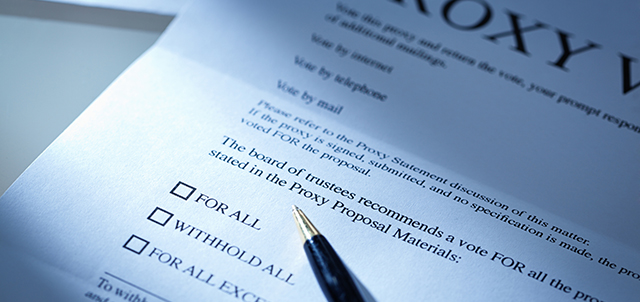Prepping for Proxy Season: A Primer on Proxy Statements and Shareholders’ Meetings

If you own stock, you’ve probably received a proxy statement. Maybe you wondered what it was or why it was sent, or you gave it a quick look and then forgot about it. But these notifications represent an important benefit of your investment: shareholder voting rights.
Proxy statements are typically sent in the spring, indicating the start of “proxy season”—when most public companies prepare to hold their annual shareholders’ meetings. State laws require public companies to hold a meeting of shareholders every year, and the Securities and Exchange Commission (SEC) requires publicly traded companies to file proxy statements ahead of annual shareholders’ meetings and special meetings. The proxy statements provide information relevant to shareholder votes scheduled for those meetings.
Most companies schedule their annual shareholders’ meetings to take place a few months after the close of the fiscal year, giving companies time to gather their financial statements and have them audited. A smaller number of companies send proxy statements and hold annual shareholders’ meetings between July and December, during what's known as the "mini" proxy season.
Want to learn more? Here are a few questions and answers to get you started.
What Happens at Shareholders’ Meetings?
Annual shareholders’ meetings generally include the election of board members, the approval of the board's selection of an auditor, a nonbinding vote on executive compensation, votes on stock option or other equity-based compensation plans, and votes on any proposals set forward by shareholders.
While shareholders have the option to travel to the meetings to vote on these matters in person, most vote in advance by mail, telephone or online due to convenience. This is referred to as voting by proxy.
Proxy statements are also sent to shareholders in advance of special meetings. Unlike annual shareholder meetings, special meetings are held only when there is an important, urgent matter to be approved by shareholders, such as the sale of a large company asset or a proposed merger.
Where Can I Find a Proxy Statement?
The SEC allows companies to post their proxy statements online instead of mailing paper copies (though shareholders may still request hard copies). Companies use mailed notices to direct shareholders to publicly accessible websites where they can find proxy statements. The SEC also makes proxy statements available through its EDGAR database.
Most retail investors, however, learn about the availability of proxy statements through an email from their brokerage firm. Since most investors' stocks are held in the "street name" of their brokerage firms, the firms are notified first of the proxy statement's release and then they in turn notify their customers. Such notifications usually include links to websites providing proxy statements as well as voting instructions.
What Can I Learn From a Proxy Statement?
A proxy statement generally includes the names and short biographies of individuals on a company's board of directors, including those who are running for reelection and new candidates chosen by the board's nominating committee. If the company has "proxy access," a provision that allows shareholder-nominated candidates to be included in proxy statements, those candidates will appear as well. The number of companies with proxy access has grown significantly in recent years, and it’s now a mainstream practice. Investors interested in determining whether a specific company has proxy access can check the investor relations page on the company’s website.
A proxy statement also details the compensation packages of a company's CEO, its chief financial officer and its three other highest paid executives. The compensation is broken down by salary, bonuses, stock options, pension benefits and more. A proxy statement's "Compensation Discussion and Analysis" section explains how compensation is evaluated and awarded, including the research performed by the company on the practices of peer group companies for the sake of determining compensation benchmarks.
Shareholder votes on executive compensation packages—known as "say on pay" votes—are nonbinding, meaning that even if shareholders reject an executive's proposed compensation, the board may award it nonetheless. However, the majority of companies receive positive votes for compensation proposals, so failed “say on pay" votes have been known to influence compensation practices.
Proxy statements also list the board of directors' appointment of an auditing firm for the coming fiscal year and ask investors to ratify that appointment. Investors can learn more about auditing firms and their relationships with publicly traded companies on the SEC's website.
Some proxy statements include charts showing a company's performance, including the performance of its stock against a benchmark index. If such information interests you and you don't see it in a proxy statement, consult a company's 10-K statement, which is typically filed one to two months before a proxy statement.
What are Shareholder Proposals?
A shareholder or group of shareholders who want to change something about the way a company does business can submit a proposal that’s included in the company's proxy statement and voted on at the annual meeting. In some cases, shareholders might call special meetings to vote on their proposals. But not all shareholders are eligible to submit proposals. Per SEC rules, a shareholder submitting a proposal must have continuously held at least $2,000 in market value or 1 percent of the company's securities for at least one year by the date the proposal is submitted. Though shareholder proposals usually fail to receive majority approval, those that garner significant support across industries can drive changes in corporate behavior.
How High Is Shareholder Vote Participation?
While institutions such as pension funds and hedge funds rarely miss a shareholder vote, individual investors have far lower participation rates. Typically, somewhere between a quarter and a third of retail investors participate in shareholder voting, as opposed to around 90 percent of institutional investors.
When shareholders don't vote and don't give their brokers instructions on how to vote on their behalf, New York Stock Exchange rules allow brokerage firms to vote on their customers' behalf in what's known as "uninstructed voting," but only in select matters deemed "routine" by the stock exchange, such as ratifying the appointment of an auditor. Other votes, such as shareholder proposals and compensation packages, aren’t eligible. When few individual investors vote on such matters, institutional investors often end up deciding the issues.
To be sure your voice as a shareholder is heard, watch for proxy statements and take advantage of your right to vote!
Learn more about investing in stock and other investing basics.



